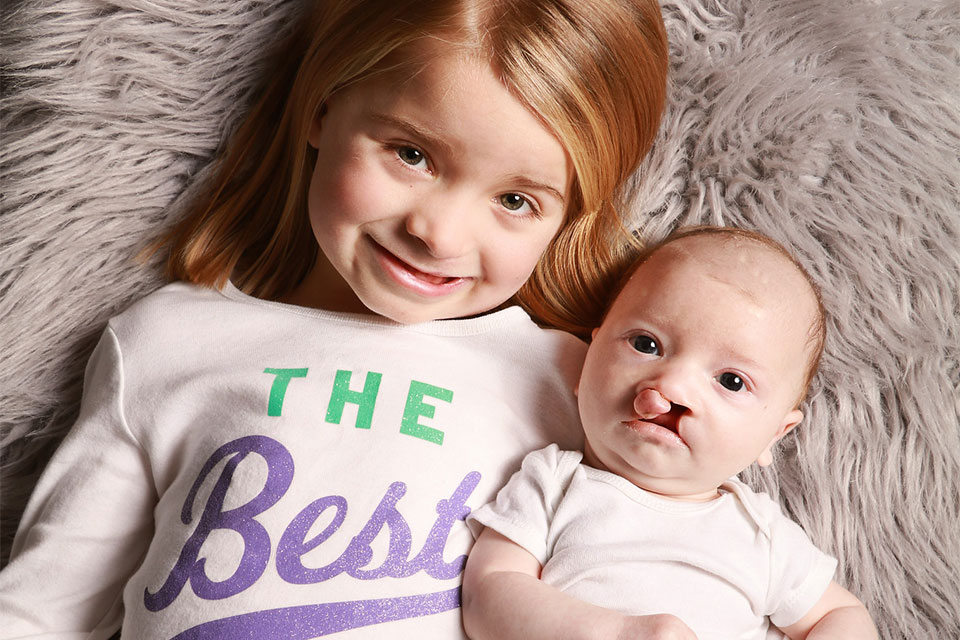Cleft Palate
Shriners Children’s provides comprehensive multidisciplinary team care with craniofacial surgery and supportive treatments shaped by the latest research.
Even though facial clefts are one of the most common birth differences in the U.S., parents may struggle to find specialized medical professionals to care for a child with cleft palate or cleft lip and palate. Working closely with young patients and their families, our goal is to repair and restore each child physically, psychologically and socially. We offer facial and dental imaging services and even 3D surgical planning for more complex surgeries.
A cleft palate occurs when the tissues that form the roof of the mouth don’t join together before birth. The opening can be repaired with reconstructive plastic surgery.
The effects of cleft palate run much deeper, causing functional changes in a child’s breathing, hearing, speaking and eating. With our multidisciplinary approach, we provide necessary and related evaluations and therapies, in multiple appointments on the same day. We focus on each child’s total health and well-being with services that also support self-esteem and your child's emotional health.
Specific treatments and services may vary by location. Please contact a specific location for more information.
Stages of Cleft Palate (cleft lip/palate) Repair:
Surgeons guide families to procedures and surgical approaches to help patients’ physical health, while creating the best possible appearance. Children may require 8 to 9 surgeries to correct the mouth, jaw and nose as they grow into adulthood. Here is an overview of what to expect.
|
Age |
Surgery |
Comments |
|---|---|---|
|
2 - 4 Months |
Cleft Lip Repair |
Ear exams/tubes |
|
6 - 12 Months |
Cleft Palate Repair |
Ear exams/tubes |
|
3 - 6 Years |
Pharyngeal(throat)/Soft Palate Surgery |
Improve speech where necessary |
|
5 - 7 Years |
Cleft Nose Surgery |
If necessary |
|
6 - 9 Years |
Bone (hip) Graft to Gum |
If child does not have enough bone for teeth to come in |
|
18 - 19 Years |
Facial Skeletal Surgery |
If upper jaw does not grow in proper relation to lower jaw |
|
18 - 19 Years |
Further Bone Graft/Dental Implant |
For patients missing teeth at cleft location |
|
14 - 18 Years |
Cleft Rhinoplasty (nose surgery) |
Almost every child will need final corrections after development. Performed earlier in patients not requiring jaw surgery. |
Children born with cleft palate will need to be followed from infancy through their teenage years. Shriners Children’s craniofacial specialists can provide the right care at the right time to give your child the best outcome.
Parents may feel overwhelmed by information but our teams will guide you step by step. Read on to learn more about the cause of cleft palate and what to expect, organized by your child's age.

From our first visit, the hospital staff treated Calvin like royalty, answered all our questions and gave us a comprehensive plan for proceeding with treatment. We love the entire cleft team.

Terilyn and Evan are siblings both born with cleft lip/palate. Shriners Children's care team provides specialists who will help them grow up to live healthy, normal lives.
Our locations treat thousands of patients with cleft palate every year. Shriners Children’s specialists are very familiar with differences in the facial anatomy of a child born with cleft, including differences in their dental health and hearing.
Dental and Orthodontic Services for Cleft Palate
Children who have a cleft will need unique dental and orthodontic care during different periods of the child’s growth.
Dentistry: Some patients with a cleft or other facial differences may have limited mouth opening, so daily teeth care is more difficult. Also, teeth may be missing or appear in the child’s palate. Shriners Children’s team of dentists understands these unique conditions and can coordinate care to provide the best appearance and bite when a child grows up.
Orthodontia: Children with cleft palate usually require a two phase treatment plan. Phase one involves a palate expander before any bone grafts that may be needed in the child’s jaw area. Phase two typically is traditional braces when patients are teenagers. Approximately 25% of children who have cleft lip or palate will require jaw surgery in their late teens to improve their bite and facial proportions.
Cleft Palate And Hearing
Children with cleft palate are more likely to have hearing issues caused by fluid buildup inside their ears. Ear tubes may be needed to reduce chronic ear infections which can affect speech and language. Shriners Children’s team care includes evaluation by audiologists and ear, nose and throat surgeons (otolaryngologists).












